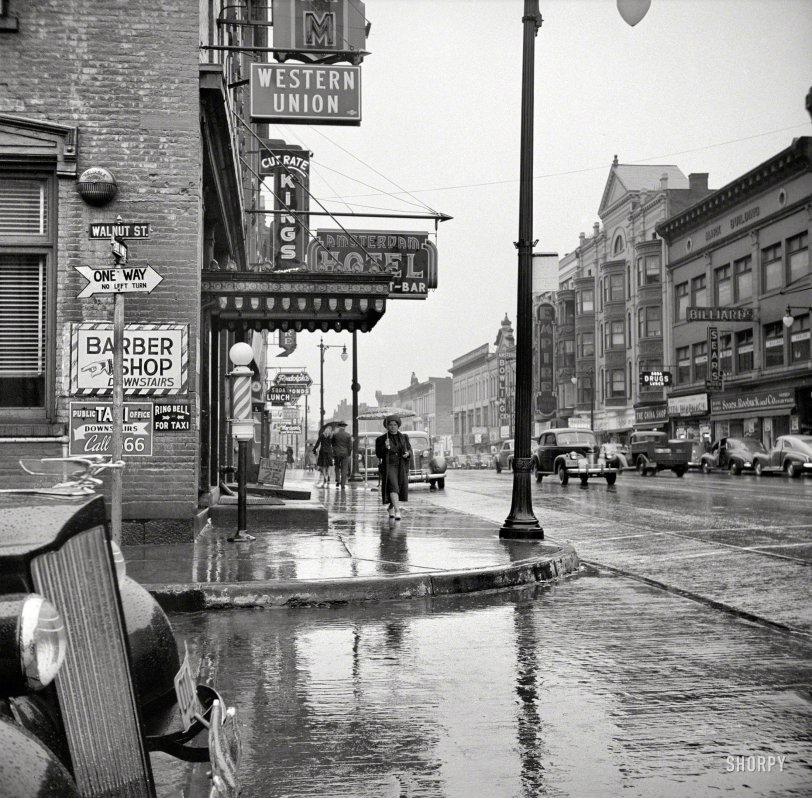


Framed or unframed, desk size to sofa size, printed by us in Arizona and Alabama since 2007. Explore now.
Shorpy is funded by you. Patreon contributors get an ad-free experience.
Learn more.

- Lofty addition
- In 1912
- Keenan Building
- Six years old
- Taken from the P.J. McArdle Roadway?
- It stood only 47 years
- Three track mind
- Incline to the right
- Reach for the sky, 1912 style
- No clean sweep
- Same Job Title, Same Face
- Sadly Lost
- Beautiful ...
- Where you get your kicks
- Aim High
- Pueblo Revival sisters
- Pueblo Neoclassicism
- Milk Man
- Regional dialect.
- Spielberg's inspiration
- Great Photo
- Loaf Story
- Do you still have the Rakes category?
- Could almost be a scene from the 1957 movie 'Hell Drivers'
- The Wages of Fear.
- Conspicuous by their absence
- Got Milk?
- All that aluminum
- No lefties
- Smoke 'em if you've got 'em
Print Emporium
Old Amsterdam: 1941

October 1941. "Amsterdam, New York." Walnut and East Main on a rainy day. Dare you to "Ring Bell for Taxi." Photo by John Collier. View full size.
Packard Deluxe Emblem - 1939
The tightly spaced vertical grille bars in combination with this hood emblem and chrome headlight bezels positively identifies the Packard as a 1939 model Packard (17th Series). The 1940 Packard's had fewer grille bars and body colored headlight bezels. No Packard hood emblem before 1939 had a glass portion (except motometers which this is obviously not). This car also has an accessory center bumper guard.
The 1939 - 1940 Packard hood emblem, finished in chrome and glass, was designed by John D. Wilson. It was given Design Patent 114,358 on April 18, 1939 (assigned to Packard). This hood ornament was used from 1939 through the cease of U.S. car manufacturing in 1942 for the duration of WWII. The rounded front of the emblem base identifies it as a 1939 or 1940 model. If the front of the base is squared off it is a 1941 or 1942 model emblem.
There are a couple of variations of this hood emblem. In 1940 the glass portion could be had with no horizontal grooves (the plain version). California car dealer Earle C. Anthony persuaded Packard to produce a version without the forward thrusting arms and wheel (the California version).
Also a Packard fan
As you did, switzarch, the first thing I saw was that dreamboat of a Packard. Would have been nice to see more of the car. They just don't make 'em that way anymore.
Crowning moment
Some of the buildings in the second block survived. Note the arched cornice. The lamposts appeared to be chopped with new fixtures applied.
Hell of a Ride
What is that missing number? Does that sign really say to call "666" for your taxi from "downstairs"?
Every building in this shot is now gone
They tore down the entire block in the early '70s and replaced it with an eyesore of a shopping center. What a shame.
The fates were not kind
Most of the buildings seen here were demolished in the 1960's or 70's for the construction of a shopping mall and a new bridge over the Mohawk River. Like its counterparts in many tired old Rust Belt cities, the mall was supposed to turn around Amsterdam's economic fortunes, which had declined when the city lost the carpet mills that had long been its mainstay. In what should come as absolutely no surprise to anyone, the mall itself failed. Today it's known as the Amsterdam Riverfront Center and mostly houses professional offices.
Amsterdam itself, like much of Upstate, is trapped in a "death spiral" of a shrinking tax base, ever-increasing tax rates, business losses, and a declining population. There are a few more fortunate spots: Elmira has benefited from natural gas extraction across the nearby Pennsylvania border; Cornell University has long been a boost to Ithaca; and Albany enjoys a measure of stability from being the home of the state government (about the only thing in Amsterdam's favor is that it's within commuting distance of Albany). Most of Upstate, however, seems to be devolving into the northern outpost of Appalachia.
Yes, Indeed
That beautiful Packard is the first thing I noticed. Very nice.
Time Travel
I wonder how many people like us, who peruse these history and photo websites, wish we could go back in time, walk these streets, stop into the shops, talk with the shopkeepers, the people on the street -- just to hear their thoughts about living in their town at this time.
What a fascinating trip that would be!
Street sign hiding digit
Taxi office downstairs and call 666?
How far downstairs is that office?
Packard, but what year?
Absolutely love this site.
My guess is 1937.
Ask the Man Who Owns One
I guess the guy who owns the Packard is at the Barber.
























On Shorpy:
Today’s Top 5